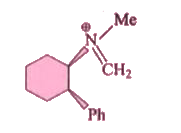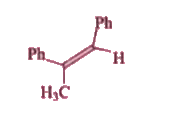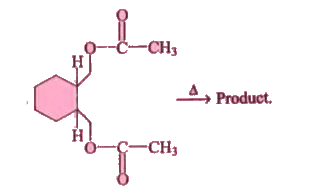Tertiary alkyl halide undergoes solvolysis in either acetic acid or in ethanol .
(a) What is the solvolysis product in each solvent
( b) In which solvent reaction is more rapid and why ?
Step-by-Step Text Solution
Given: A tertiary alkyl halide undergoes solvolysis in either acetic acid or ethanol.
Part (a): Solvolysis Products in Each Solvent
1. Understanding Solvolysis:
- Solvolysis is a reaction where the solvent acts as a nucleophile. In this case, both acetic acid and ethanol can act as nucleophiles.
2. Structure of Tertiary Alkyl Halide:
- Let's consider a tertiary alkyl halide, for example, tert-butyl bromide (C4H9Br).
3. Solvolysis in Acetic Acid:
- In acetic acid (CH3COOH), the acetate ion (CH3COO-) will act as the nucleophile.
- The bromine atom (leaving group) departs, forming a carbocation (C4H9+).
- The acetate ion then attacks the carbocation, leading to the formation of tert-butyl acetate.
- Product: Tert-butyl acetate (C4H9OCOCH3).
4. Solvolysis in Ethanol:
- In ethanol (C2H5OH), the ethoxide ion (C2H5O-) acts as the nucleophile.
- Again, the bromine atom leaves, forming a carbocation.
- The ethoxide ion attacks the carbocation, resulting in the formation of tert-butyl ethyl ether.
- Product: Tert-butyl ethyl ether (C4H9OC2H5).
Part (b): Rate of Reaction in Each Solvent
1. Comparison of Solvents:
- The rate of solvolysis reactions is influenced by the polarity of the solvent. Polar protic solvents are preferred for SN1 reactions because they stabilize the carbocation intermediate.
2. Dielectric Constant:
- The dielectric constant is a measure of a solvent's polarity. Higher dielectric constants indicate better stabilization of charged species.
- Ethanol has a dielectric constant of 24.5, while acetic acid has a dielectric constant of 6.2.
3. Conclusion:
- Since ethanol has a higher dielectric constant, it stabilizes the carbocation more effectively than acetic acid.
- Therefore, the reaction will be more rapid in ethanol compared to acetic acid.
Final Answers:
- (a) In acetic acid, the product is tert-butyl acetate. In ethanol, the product is tert-butyl ethyl ether.
- (b) The reaction is more rapid in ethanol due to its higher dielectric constant.
---
- Solvolysis is a reaction where the solvent acts as a nucleophile. In this case, both acetic acid and ethanol can act as nucleophiles.
- Let's consider a tertiary alkyl halide, for example, tert-butyl bromide (C4H9Br).
- In acetic acid (CH3COOH), the acetate ion (CH3COO-) will act as the nucleophile.
- The bromine atom (leaving group) departs, forming a carbocation (C4H9+).
- The acetate ion then attacks the carbocation, leading to the formation of tert-butyl acetate.
- Product: Tert-butyl acetate (C4H9OCOCH3).
- In ethanol (C2H5OH), the ethoxide ion (C2H5O-) acts as the nucleophile.
- Again, the bromine atom leaves, forming a carbocation.
- The ethoxide ion attacks the carbocation, resulting in the formation of tert-butyl ethyl ether.
- Product: Tert-butyl ethyl ether (C4H9OC2H5).
- The rate of solvolysis reactions is influenced by the polarity of the solvent. Polar protic solvents are preferred for SN1 reactions because they stabilize the carbocation intermediate.
- The dielectric constant is a measure of a solvent's polarity. Higher dielectric constants indicate better stabilization of charged species.
- Ethanol has a dielectric constant of 24.5, while acetic acid has a dielectric constant of 6.2.
- Since ethanol has a higher dielectric constant, it stabilizes the carbocation more effectively than acetic acid.
- Therefore, the reaction will be more rapid in ethanol compared to acetic acid.
- (a) In acetic acid, the product is tert-butyl acetate. In ethanol, the product is tert-butyl ethyl ether.
- (b) The reaction is more rapid in ethanol due to its higher dielectric constant.
Topper's Solved these Questions
- BOOK - AAKASH INSTITUTE ENGLISHCHAPTER - HALOALKANES AND HALOARENES EXERCISE - Assignment (Section - I) (Aakash Challenger Questions)10videos
HALOALKANES AND HALOARENES
- BOOK - AAKASH INSTITUTE ENGLISHCHAPTER - HALOALKANES AND HALOARENES EXERCISE - Try Yourself40videos
HALOALKANES AND HALOARENES
- BOOK - AAKASH INSTITUTE ENGLISHCHAPTER - HALOALKANES AND HALOARENES EXERCISE - Assignment (Section - H) (Multiple True -False Type Questions)2videos
HALOALKANES AND HALOARENES
- BOOK - AAKASH INSTITUTE ENGLISHCHAPTER - GENERAL PRINCIPLES AND PROCESSES OF ISOLATION OF ELEMENTSEXERCISE - Try Yourself33videos
GENERAL PRINCIPLES AND PROCESSES OF ISOLATION OF ELEMENTS
- BOOK - AAKASH INSTITUTE ENGLISHCHAPTER - HYDROCARBONSEXERCISE - Assignment(Section - C) (Previous Years Questions)60videos
HYDROCARBONS
Similar Questions
In SN2, solvolysis RX in which the solvent is a nucleophile, what is the order and molecularity of the reaction ?
View SolutionRead the given passage and answer the questions number 1 to 5 that follow:
The substitution reaction of alkyl halide mainly occurs by SN1 and SN2 mechanism. Whatever mechanism alkyl halides follow for the substitution reaction to occur, the polarity of the carbon halogen bond is responsible for these substitution reactions. The rate of SN1 reactions are governed by the stability of carbocation whereas for SN2 reactions steric factor is the deciding factor. If the starting material is a chiral compound, we may end up with an inverted product or racemic mixture depending upon the type of mechanism followed by alkyl halide. Cleavage of ethers with HI also governed by steric factor and stability of carbocation, which indicates that in organic chemistry, these two major factors help us in deciding the kind of product formed
1. Predict the stereochemistry of the product formed if an optically active alkyl halide undergoes substitution reaction by SN1 mechanism.
2. Name the instrument used for measuring the angle by which the plane polarised light is rotated.
3. Predict the major product formed when 2-Bromopentane reacts with alcoholic KOH.
4. Give one use of CHI3
5. Write the structures of the products formed when anisole is treated with HI.View Solution
Knowledge Check
- Question 1 - Select One
There are number of organic compounds including esters, xanthate esters, amine oxides etc., that undergo pyrolytic elimination with heat in the absence of added reagent, either in inert solvent or in the absence of solvent. In general these elimination follow the rate law.
Rate ∝ =[Substrate]
However reaction is different from E1 elimination by the degree of syn-stereoselectivity that they exhibit. These reactions are also known as Ei elimination and the degree of syn-stereoselectivity reflect the extent to which they proceed via cyclic transition state.

Find the major product of the following reaction :
 A
A B
B C
C DNone of these
DNone of these - Question 2 - Select One
There are number of organic compounds including esters, xanthate esters, amine oxides etc., that undergo pyrolytic elimination with heat in the absence of added reagent, either in inert solvent or in the absence of solvent. In general these elimination follow the rate law.
Rate ∝ =[Substrate]
However reaction is different from E1 elimination by the degree of syn-stereoselectivity that they exhibit. These reactions are also known as Ei elimination and the degree of syn-stereoselectivity reflect the extent to which they proceed via cyclic transition state.


Find the major product of reaction :A B
B C
C DNone of these
DNone of these - Question 3 - Select One
There are number of organic compounds including esters, xanthate esters, amine oxides etc., that undergo pyrolytic elimination with heat in the absence of added reagent, either in inert solvent or in the absence of solvent. In general these elimination follow the rate law.
Rate ∝ =[Substrate]
However reaction is different from E1 elimination by the degree of syn-stereoselectivity that they exhibit. These reactions are also known as Ei elimination and the degree of syn-stereoselectivity reflect the extent to which they proceed via cyclic transition state.


Find the structure of product :A B
B C
C D
D
(a) Why do acyl chlorides undergo nucleophilic attack more readily than alkyl chlorides ?
(b) What is hydroxamic acid test and which functional group is determined by this test ?View Solutiona : When 3∘ alkyl halide is used in Williamson 's synthesis what will be the major product and why ?
b : When 3∘ alkoxide is used in Williamson's synthesis what will be the major product and why ?View SolutionIn an experiment to estimate the size of a molecule of oleic acid 1 mL of oleic acid is dissolved in 19 mL of alcohol. Then 1 mL of this solution is diluted to 20 mL by adding alcohol. Now, 1 drop of this diluted solution is placed on water in a shallow trough. The solution spreads over the surface of water forming one molecule thick layer. Now, lycopodium powder is sprinkled evenly over the film and its diameter is measured. Knowing the volume of the drop and area of the film we can calculate the thickness of the film which will give us the size of oleic acid molecule.
Read the passage carefully and answer the following questions
(a) Why do we dissolve oleic acid in alcohol ?
(b) What is the role of lycopodium powder?
(c) What would be the volume of oleic acid in each mL of solution prepared?
(d) How will you calculate the volume of n drops of this solution of oleic acid ?
(e) What will be the volume of oleic acid in one drop of this solution ?View SolutionWhich one of the following alkyl bromides undergoes most rapid solvolysis in methanol solution to give corresponding methyl ether?
View SolutionOf the following statements which are true for SN1 reaction.
(a) Tertiary alkyl halides react faster than secondary.
(b) The absolute confuguration of the product is oppsoite to that of the reactant when an optical active substrate is used.
(c) The reactio shows first order kinetics.
(d) The rate of reaction depends markely on the nucleophilicity of the nucleophile.
(e) The mechanism is two step.
(f) Carbocations are intermediate.
(g) Rate =K[Alkyl][halide]
(h) The rate of teh reaction depends on the nature of the leaving group.View Solution

